I used to use tumblr as a fangirl now I use it for school and cool pics.
Don't wanna be here? Send us removal request.
Text
This is such a great analysis and I think you chose an excellent work to compare it to. The Allegory of the Cave is very central to understanding how we think of our own existence and purpose. ATLA wrestles with these questions of purpose a lot, and I think it makes it especially interesting that it's all young people who are the protagonists of the show, because they are discovering their purpose in a normal teenage-young adult way but also in a magical bending way.
@theuncannyprofessoro
Avatar: The Last Airbender, the Formalist Symbolism of Shot Composition
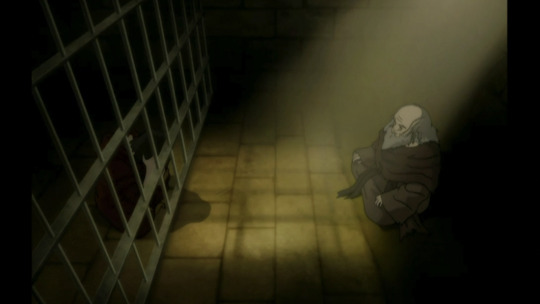
Link to Video Essay
The series, Avatar: the Last Airbender, remains one of the most critically acclaimed animated shows over a decade after its original debut in 2005. Intricate world-building, an immersive score, and themes of genocide, totalitarianism, Stockholm Syndrome, redemption, and spiritual balance are partially what cultivate and cement ATLA’s memorability to a degree that prompts recognition from outlets such as Vanity Fair, IndieWire, and general audiences years after its premier. It is a heroes’ journey about restoring balance, cross-cultural understanding, and peace after the Fire Nation waged war. However, it is also filled with striking visual storytelling, its awareness of semiotic significance and the delicacy through which it handles visual rhetoric.
While lighting, camera angles, and shot composition are used as formalist signifiers throughout the entire show, I will specifically be focusing on the scene where Zuko visits Iroh in the jail cell. For context, Zuko has been accepted back into the Fire Nation by conforming to their current ideals of ethnocentrism and helping their efforts in the war. Simultaneously, Iroh has been othered and imprisoned for treason because of his rejection of these same ideals. Thus, we know contextually that the two characters are performing and interpreting their racial identities differently. The composition of the scene through its lighting and camera angles, however, adds another layer of commentary to the duality of these two characters. It communicates that while Iroh is physically othered and imprisoned for his enlightened perspective on what it means to perform his racial identity, Zuko is embraced and accepted for his antithetically ignorant perspective on the Fire Nation.
Through its use of light and dark imagery as symbolic concepts within the scene, ATLA demonstrates what Sergei Eisenstein describes as “a cinema that seeks the maximum laconicism in the visual exposition of abstract concepts” in his article, “Beyond the Shot [The Cinematographic Principle and the Ideogram].”[1] The light streaming in from the small window in Iroh’s prison cell represents the concept of enlightenment and awareness while Zuko kneels helplessly in the shadows. This is a subversion of expectations, as Iroh is imprisoned, looked down on, and othered within his nation, yet the light implies he should be treated antithetically. The role reversal between the isolated yet enlightened prisoner and the idolized yet ignorant prince is further emphasized through the stark duality of light and shadow. Eisenstein describes the composition of shots and visual symbolism as a necessary type of collision, writing “What then characterizes montage and, consequently, its embryo, the shot? Collision. Conflict between two neighboring fragments. Conflict. Collision.”[2] Few visual elements mirrored across hundreds of years of symbolic imagery more aptly demonstrate conflict and collision within a shot than the light and the dark—the collision, conflict, and interplay between shadows and the sun that expels them.
Applying the argument for collision within a shot to lighting specifically, Eisenstein states, “The same applies to the theory of lighting. If we think of lighting as the collision between a beam of light and an obstacle, like a stream of water from a fire hose striking an object, or the wind buffeting a figure, this will give us a quite differently conceived use of light from the play of ‘haze’ or ‘spots.’”[3] Through this framing, there is not only the existence of light and shadow within a shot but a battle between them—an apt description considering the broader plot of war between ethnocentrism and cross-cultural unity that permeates Avatar’s world, as well as Zuko and Iroh’s representations of these ideologies respectively. Light and shadow can coexist, yet this coexistence is constantly implicated with the power struggle between the two. Avatar’s shots in the prison scene put light and dark imagery similarly in conflict, further explaining why one must be othered and the other accepted by their nation.
Eisenstein explains, however, that these abstract concepts necessitate an intertextual basis that grounds them in signified meaning. Speaking to how visual signifiers develop culturally understood meanings over time and in relation to the context clues around them, Eisenstein writes that within forms like the Haiku and Tanka, “The method, reduced to a stock combination of images, carves out a dry definition of the concept from the collision between them.”[4] Avatar’s visual rhetoric plays out similar to poetic communication, drawing on the idea that shadows and light, when placed together create meaning. Bolstering the significance of this collision with the shot is a history of cultural ideas and philosophical texts that perpetuate similar associations. Eisenstein recognizes how this type of intertextuality strengthens symbolism, writing, “The same method, expanded into a wealth of recognized semantic combinations, becomes a profusion of figurative effect.”[5] The integration of atramentous and brightened hues into common modern cultural perceptions is seen through how it manifests in language, with common expressions like being in the dark.
One may question how the depth of the scene's commentary about enlightenment and ignorance can go much further past this stark dichotomy, as the conceptualization of light and darkness arguably only allows for a black-and-white interpretation of Iroh and Zuko's characters. However the meaning behind the use of shadows is strengthened even further when considering what is perhaps the most famous use of dark and light symbolism across millenia—Plato’s acclaimed allegory of the cave. Plato paints a visual picture of prisoners who live in an underground cave and can only see a wall where the shadows of various objects are projected. Thus, they believe shadows to be reality. Once a prisoner escapes and sees not only the objects that were originally creating the shadows, but also the sun above, he is described as enlightened, having a fuller view of reality.
The shot plays on this symbolism by intentionally depicting Zuko staring down at the shadows of the prion bars while Iroh stares at Zuko directly. This indicates that, much like the prisoners in Plato’s allegory, Zuko is shrouded in ignorance, unable to see how his compliance with ethnocentrism is not inherently necessitated by him being the prince of the Fire Nation. Iroh, on the other hand, sees the real prison bars and from his perspective, Zuko is the one behind those bars, as is emphasized by the camera angles in the scene being shot from inside the cell looking out. Iroh sees a clearer version of reality, understanding a racial performance detached from the Fire Nation’s current culture, and realizing Zuko is mentally imprisoned.
The prison scene is a poignant example of the type of formalism that Eisenstein explores. ATLA’s montage demonstrates “precisely what we do in cinema, juxtaposing representational shots that have, as far as possible, the same meaning, that are neutral in terms of their meaning, in meaningful contexts and series.”[6] The series of shots that comprise this scene strengthens its visual storytelling, as each shot—its perspective and composition—further emphasizes the dichotomy between the two characters within it. Astoundingly, a 3 minute scene has the capacity to communicate the “collision” of othering versus acceptance; cultural enlightenment versus ignorance; and ethnocentrism versus global unity personified between two of the show’s protagonists.
[1] Sergei Eisenstein,“Beyond the Shot,” Film Theory and Criticism, (2009): 15
[2] Eisenstein, “Beyond the Shot,” 19
[3] Eisenstein, “Beyond the Shot,” 21
[4] Eisenstein, “Beyond the Shot,” 15
[5] Eisenstein, “Beyond the Shot,” 15
[6] Eisenstein, “Beyond the Shot,” 15
@theuncannyprofessoro
6 notes
·
View notes
Text
Your video essay is awesome and this is super legit analysis. The part about Jason and Chidi was especially interesting and made me wonder, were the writers trying to un-stereotype when they created the characters? Both of them are antithetical to prevalent conceptions about large racial groups (i.e. smart asian people, hypermasculine black guys), in a way that makes me think it was done in a spirit of subversion of the status-quo. But, as you point out, in making them directly opposite to the stereotypes they attempt to rebuff, they reinforce them by reminding audiences of the untruth/generalization in the first place. I think it would be great if the writers were able to preserve the humor and sweetness of Jason and Chidi's beguiling awkwardness without leaning in so much to the status-quo (but backwards).
@theuncannyprofessoro
Critical Television Analysis: The Good Place
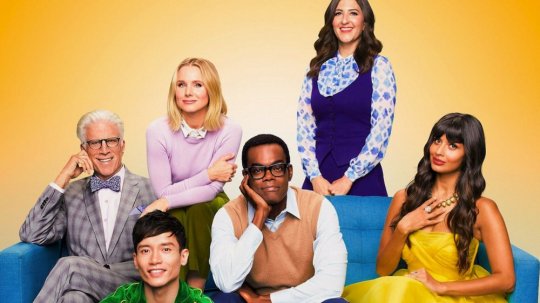
On the surface, The Good Place is well-loved, hilarious, and surrounds a diverse cast with characters that differ from identity-related stereotypes. The show surrounds Eleanor, who wakes up in heaven, referred to as the “Good Place,” alongside Tahani, Jason, and Chidi (who is labeled her soulmate). Michael is the supposed leader of the “Good Place,” but we later discover that–in alignment with Eleanor’s selfishness–he is actually a devil and this is the “Bad Place.” The characters’ out-of-placeness (except for Tahani and Chidi, who initially think they belong) is meant to be their eternal torture, but Eleanor’s repeated solving of this mystery results in endless reboots and failures. The series ends when the humans team up with Michael and they realize that the entire system is off, as everyone is being sent to the “Bad Place” based on its unattainable, binary measures of morality. They successfully reform the system, resulting in Michael’s transformation into a good being–and living out his fantasy of being a ‘human’ on Earth–and Eleanor, Chidi, and Jason transforming into blissful nothingness while Tahani helps to design a better afterlife.
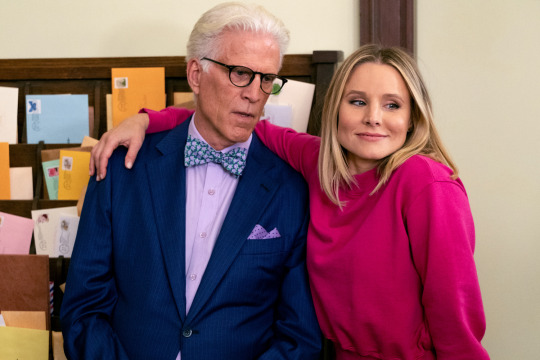
Photo: Michael and Eleanor.
Although we eventually learn that everyone is being sent to the “Bad Place,” the show’s group of focus is diverse (through their sexuality, gender, or race), generalizing “Bad” people to be those who defy hegemonic norms. This mirrors our current society, especially with those in control being white men (like Michael & the other Devils, and one white female judge) with outdated ideology–I explore this further in my video essay. While the final message of the show recognizes this point system as flawed, revealing the lack of a binary good/badness (the main point of my video essay), it doesn’t at all explore the sexual, gendered, and racial aspects of the characters’ intersectional experiences, making the show more hegemonic than not. I analyze the portrayal of specific characters and how these may be negatively interpreted by viewers despite this show’s positive overall message.

Photo: Tahani, Jason, Eleanor, and Chidi as they stand before the judge and request the chance to 'start' life--and their "Good" vs "Bad" point count--from scratch.
I critique responses to The Good Place that commend its progressiveness based on the fact that its cast is racially diverse and they don’t align with traditional stereotypes, and instead suggest that in this case, “not all representation is good representation” (Hsu, 2021). The show fails to reconstruct intersectional identities in a positively ‘different’ way due to its “color-blind” approach, which disregards, rather than reconstructs, gendered and racialized oppression throughout history. The non-hegemonic aspects of characters’ racial or gender identities are dampened through their adoption of traits that reinforce hegemonic ideology; this is particularly prominent among the female characters, however I address the male characters prior to my conclusion. Primarily, each female character represents an atypical, but similarly problematic form of femininity that continues to reflect the male gaze; Eleanor’s narrative control as a woman is dampened through her alignment with hegemonic masculinity–this is heightened by Chidi’s femininity (perpetuating an innate gender binary), Janet’s non-binary identity is overridden by their similarity to the ideal, domesticated woman (reasserting heteronormativity as the norm), and Tahani’s Pakistani background is misportrayed through her assumption of a privileged white-washed identity (making racial histories invisible) (Kaplan, 2010). Kaplan, Shohat, and Diawari note that the significance of media’s portrayal of gender and race lies in its influence on the minds of its viewers; what media constructs is perpetuated and eventually, realized within our own reality, pointing to the significance of recognizing ideological media as such before its perpetuation. While the presence of three female characters in the show’s main ensemble provide us with the illusion of gender equality, upon closer analysis it is clear that each reinforces problematic stereotypes surrounding race and gender.
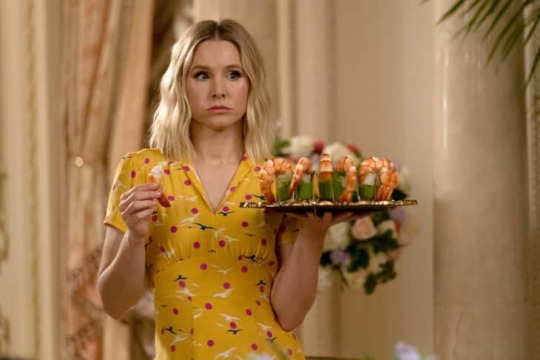
Primarily, the protagonist is a white woman–the show opens with a shot of her face, bright and glowing, and follows her perspective throughout the narrative. Eleanor’s non-feminine, general indifference is framed as the essence of her personality, and resultantly, the reason behind her punishment. Kaplan notes that attempts to reconstruct female characters in defiance to gender norms can fail through their consistent creation of a male/female binary; “our culture is deeply committed to clearly demarcated sex differences.” Eleanor illustrates Kaplan’s point that emerging female “representation” remains binarized, as she adopts a specifically masculine position that is characterized by her lack of “traditionally feminine traits,” particularly, her “cold and manipulative” personality (Kaplan, 2010). Flashbacks of Eleanor’s life on Earth revealed that everyone hated her because of her manipulative ways and carelessness surrounding others’ feelings. On Earth, Eleanor used to get drunk before going out with her work colleagues on the night she was designated driver, just to joke that the only place she’d be driving was through the “loophole” she found in the system… When she’s (finally) forced to stay sober and drive, she pretends to be doing it out of care for her friends to get the bartender’s attention, and later chooses going home with him while stranding her drunk friends at the bar. Needless to say, Eleanor isn’t invited to go out with her colleagues again.

This careless emotionlessness is counteracted by Chidi’s “kindness, humaneness, and motherliness,” evident in the fact that his personality surrounds his nervous awkwardness and indecisiveness based on a desire to make the most moral, utilitarian decisions possible (Kaplan, 2010). Many viewers think Chidi illustrates “positive masculinity,” but his emotionality and indecisiveness–alongside a resulting inability to “take action” in the way Eleanor does–suggest he may align with the feminized role as described by Kaplan (Kaplan, 2010). Moreover, Chidi is used to counteract Eleanor’s masculinity and keep the gendered binary “structure intact” despite the supposed stray from hegemonic gender norms (Diawara 2014, Kaplan, 2010).
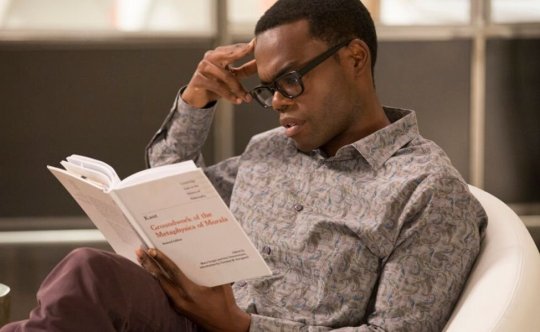
The idea of Eleanor’s defiance of traditionally feminine gender norms is directly framed as related to her “badness” through her narrative arc, in which her transformation into a “good person” directly aligns with her acceptance of hegemonic femininity; she adopts “kindness, humaneness, and motherliness” and heteronormativity (Kaplan, 2010). When the humans are given the chance to live again and restart their point count, Eleanor struggles; as soon as Chidi kisses her and they recognize their feelings, she finally does better on Earth and becomes “good.” While one could argue the arc’s alignment with heteronormativity is purely coincidental, it contrasts with the show’s previous focus on Eleanor’s bisexuality, aka, its queerbaiting of Eleanor. Throughout early seasons, Eleanor frequently commented on Tahani’s attractiveness, and even came close to kissing Simone (Chidi’s gf at the time); the usage of her bisexuality is, in itself, framed inappropriately comically, and coincides with her previously “masculine” traits– carelessness, moral indifference, and lack of romantic interest in Chidi–suggesting non-heteronormativity to be similarly negative. Moreover, the fact that Eleanor is a woman does not necessarily mean she’s a progressive character, as is evident in her adoption of a non-feminine, but similarly binary form of masculinity, the presence of Chidi as a feminine counterpart , and the show’s aligning of her bisexuality with “badness.”
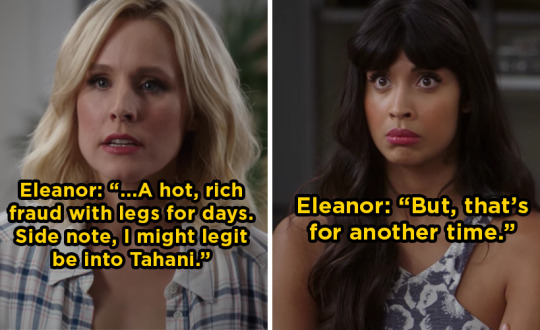
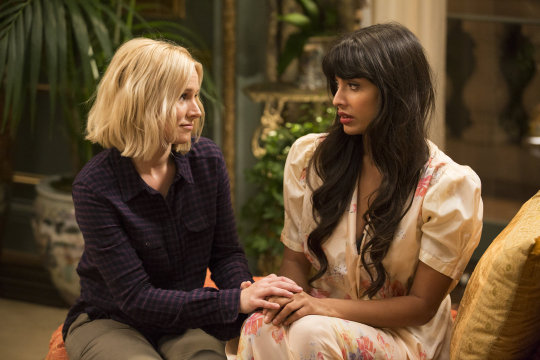
Photo: Eleanor and Tahani
Janet, a white character, is framed as the perfect woman, which is problematic due to their identification as non-binary, both because it is transphobic and frames servitude (her main purpose) as innately feminine. Primarily, I noticed that Janet mirrors our assignment of femininity to technological sources of servitude: Siri, Alexa, GPS navigation, “the number you have dialed is not in service…” Like these objects, Janet’s “servitude and obedience” are viewed as innately feminine, and are thus assigned a feminine identity (James, 2018). Despite Janet’s attempts to reclaim their lack of alignment with societal labeling norms through the consistent assertion that they are not female, but rather a vessel of knowledge (equating themself to AI), characters always call them a “girl.” Janet never argues with this misgendering, and instead responds with a smile and a kind, “Once again, I’m not a girl” (Beck, 2023). While Janet’s character could have been an opportunity to explore a non-hegemonic perspective, the show harms non-binary identities more than it supports them, by enabling characters to misgender Janet and using their feminine appearance (always fresh, made-up, and in a dress) and feminine subservience to justify this assumption as comically obvious and justifiable (Beck, 2023). The show actually perpetuates their femininity so much that their character is referred to as a girl both within and out of the narrative (among characters and audience members). In the end, Janet is framed as a woman in nature despite their assertion of being non-binary, both aligning femininity with object-ness and servitude and framing non-binary identities as lacking personhood. The show uses Janet as a diversity point without truly questioning binarized views of gender; Janet’s consistent positivity and agreeability disregard the harm of misgendering, and actually works to justify the characters who misgender her by framing Janet’s “femme” physicality and personality as evidence of their ‘obvious’ femininity (Beck, 2023).

Just as Janet’s intersectionality is subdued through their over feminization, the only other intersectional identity (and the only non-white woman) of focus–Tahini–is made palatable through the show’s white-washing of her personality. While Tahani is a first generation Pakistani in the United Kingdom, her struggle-free experience in white-dominated high society disregards a perspective representative of non-white culture, and instead hides it with a British accent and Tahani’s infinite wealth. Tahani’s lack of race-related struggles are completely disregarded through her defining trait: selfishness. Even her greatest deeds, such as organizing charities on Earth, were all based on selfish intentions surrounding her parents’ validation. Her biggest struggle is framed as her sister’s fame, specifically, her parents’ heightened love of her sister, which aligns with Tahani’s inherent self-focused attitude. In this way, UK’s historical colonization of Pakistan and the current othering of British Pakistani are made invisible. (Aljazeera, 2023). As noted by Shohat, attempting to re-frame gendered and racial history (patriarchy and colonialism) is not always done in an “unproblematic” way, just as The good Place’s color-blindness to Tahani’s racial history actually perpetuates social ignorance of historical oppression. In alignment with Shohat’s explanation of the “mark of the plural,” in which any “negative behavior” (Tahani’s personality-defining selfishness) is viewed differently based on the characters’ race, Tahani’s characterization is more likely to be generalized to Pakistani people than Eleanor’s would be to white people (Shohat, 2014). Tahani’s obliviousness to her culture’s oppression projects a falsely generalized idea of this racialized history as insignificant among Pakistani despite its continued prevalence.
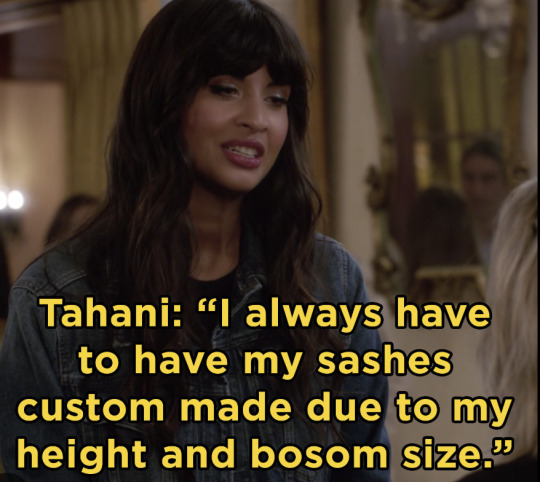
While I mainly focus on female identities (complicated by Janet), The Good Place frames the experiences of Jason, and Chidi (in addition to Tahani) as completely unaffected by their race. Jason’s ability to pass as a Taiwanese monk due to him being Asian–despite the fact that he’s from Florida and is not a monk–perpetuates essentialist ideology surrounding sameness based on race, and his heightened lack of intelligence is a poor choice for the only Asian representation throughout the show. Chidi’s violation of hegemonic masculinity (through his emotionality, indecisiveness, etc.) being framed as the reason he resides in the Bad place aligns with problematic characterizations of Black characters “playing by hegemonic rules and losing” (Diawara, 2014). More broadly, the fact that Chidi, Jason, and Tahani are supporting characters for a white woman–like many other characters of color–repaints white-washed film narratives in which POC don’t hesitate to “protect” the “same order that has punished and disciplined” them (Diawara, 2014).
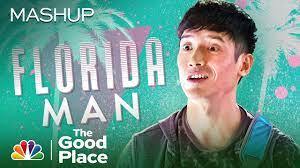
The afterlife’s similarity to Earth suggests its culture as to be reminiscent of our own, however, the color-blind attitude of the main characters disregards the rampant racism that we still work to subdue. Unfortunately, The Good Place’s opportunity to explore an array of perspectives and lived experiences through characters’ diverse backgrounds is lost, even just based on the nature of their show; they do not take into account that the negative representations assigned to each of its characters have a different impact on their community. The fact that a white man created “The Good Place” isn’t surprising, and points to Shohat’s recognition of the necessity for “historically marginalized” groups to “control their own representation” to avoid reproducing something from a white audience’s lens of “pleasure” (Shohat, 2014).
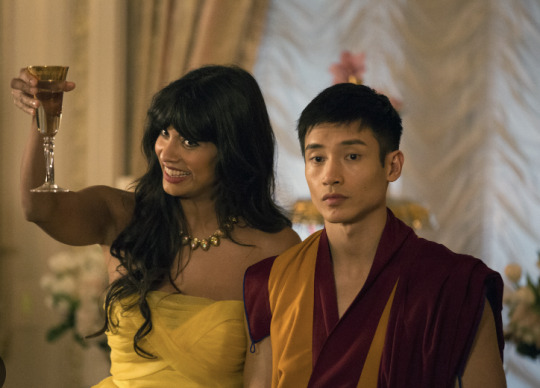
Photo: Tahani and Jason.
Works Cited:
Beck. “‘I’m Not a Girl’: Janet, Nonbinary Representation and ‘The Good Place.’” The Spool. Accessed December 12, 2023.
Diawara, Manthia. "13 Black Spectatorship: Problems of Identification and Resistance." Black American Cinema (2012).
Hsu, Leina, Ruchi Wankhede, Ayan Omar, and Jennifer Ammann. “No, the Good Place’s Jason Mendoza Does Not Defy Asian Stereotypes.” Women’s Republic, March 1, 2021.
James, et al. “The Other Secret Twist: On the Political Philosophy of the Good Place.” Los Angeles Review of Books, October 13, 2018.
Kaplan, E. Ann. "Is the gaze male?." (2010).
Shohat, Ella, and Robert Stam. Unthinking Eurocentrism: Multiculturalism and the media. Routledge, 2014.
Staff, Al Jazeera. “Braverman Words on British Pakistani Men Discriminatory: Pakistan.” Al Jazeera, April 5, 2023.
@theuncannyprofessoro #oxyspeculativetv #speculativetvanalysis
12 notes
·
View notes
Text
I find the conversation between The Meep and The Doctor very interesting, especially when The Doctor said "Oh, I do that.". It's funny because the scene is kind of an exaggeration of common conversation now where people disclose their pronouns. I feel like this scene acknowledges the discomfort of this interaction while also making it not awkward or bad. Like, people who don;t necesarily "get" pronoun preferences can still respect it as a thing, which is shown beautifully here. Great video essay!
@theuncannyprofessoro
Performing Gender: Doctor Who and The Star Beast
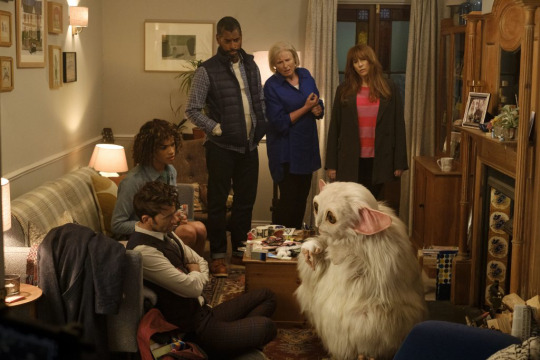
youtube
The topic I would like to discuss today is gender representation in Doctor Who. For this discussion, I will be specifically analyzing one of the most recent episodes that came out entitled The Star Beast. In order to analyze the Doctor Who episode, I will be using Judith Butler's article “Gender is Burning: Questions of Appropriation and Subversion.” My three main discussion points will be Rose noble, Donna Noble's trans daughter. Um, the discussion surrounding pronouns and alien races as a metaphor for gender presentation. At this time, I would like to acknowledge that I could have used discussed alien races as a metaphor for race in general. However, given that most of this episode is centralized around discussions of gender identity and sort of being trans gender pronouns, um. Just gender in general. I felt it was better to talk about it as a gender presentation and what people will accept as a gender presentation versus what is not acceptable as a presentation.
I want to begin by discussing Donna Noble's daughter, Rose. Rose is transgender, and I think the show does a very good job of integrating that into the plot and making it applicable. For example, rather than having her just be played by a trans actress and having it be like a side mention, it is an actual part of the plot and acknowledges real life moments that happen for trans people. The scene between Donna and her mother discussing um. Rose is, in my opinion, one of the best moments of the entire 60th anniversary and honestly, one of my favorite moments in television. It is a genuine acknowledgment of the trans experience and how you will have family that are genuinely accepting of you, but also is confused. It is not painted, though, in a bad light. It is painted in the light of oh. They care and they are trying, but it's not necessarily immediate. I think this is a very good scene. I think it sets the episode off in a very good light because it sets us up to discuss gender in a way where it's acknowledging that, um, gender presentation and how we sort of perform it is still something that is relatively new r for older generations. And it sets up why the big plot twist surrounding the aliens works out, because we are still very set in our ways, even though we are becoming more and more liberal.
The second point I have is about the discussion of pronouns. This is a very sort of pivotal scene. It's been shown all over TikTok. And it is where Rose makes the point that the meep, um, might not use he/him pronouns because the doctor assumes that the meep does. To note, the meep is a little funky alien. that crash lands on Earth, and then Rose finds it hiding in her trash cans. I feel that the discussion between the doctor and the meep about pronouns. Brilliantly illustrates Judith Butler's point about how gender, performance, and specifically drag is “one which both appropriates and subverts racist, misogynist and homophobic norms of oppression.”[1] I believe that it sort of subverts it, because it makes it sort of a normalized thing. When Rose points out that the doctor assumed pronouns, the doctor immediately asks. And when the meep says, “I use the definite article, I am always the meep,” The doctor does not see that as strange. He's just like, oh yeah, I do that too sometimes. However, it also at the same time appropriates it because it creates this sort of camaraderie feeling that is then pushed aside in when we get to the later half of the episode, which is sort of the discussion about alien races and gender presentation.
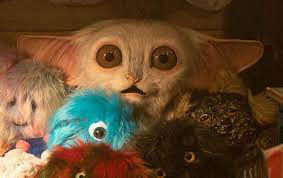

The last main point I want to discuss is gender presentation with alien races. And this is more sort of going into the idea of various races as different acceptable forms of presentation. As I said, this would also be a very good topic to cover under race. However, I felt that I wanted to stick with gender theory for the sake of this video and this assignment. So if we look at the photos of the meep and then of the Ross Warriors, who are the sort of bug-like creatures. One is very clearly more palatable for human beings. I mean, I know personally when I watch the episode, one of the first things I said was, oh, I wonder when they're going to make a meep plushie because it's, um, the meep is cute. It's fuzzy. It's just very much the kind of thing that human beings latch on to and are like, oh, what a baby. Whereas the Wrath warriors are scary. They look like bugs, something that we inherently fear. Judith Butler directly discusses how gender and gender performance is not separate from sexuality and race. She makes a point when talking about symbolic gender, that “the symbolic is also and at once a racializing set of norms, and that norms of realness by which the subject is produced or racially informed conceptions of sex.”[2] In this sense, we can see the connections between gender presentation and the alien races. We take the symbolic thing of the meep looking small and cute and friendly, and in return decide that must mean the meep is good, that the meep is not the one at fault here. Instead, it must be that these evil warriors are the villains, when in reality it's completely opposite. The warriors are just trying to enact justice. They're trying to arrest a genocidal maniac. But because we see them as more threatening throughout the first half of the episode, without question, everyone immediately goes to the side of the meep. It is only once the doctor has actually exposed the meep for who it is that the meep reveals itself and everyone begins to hate it. To conclude, the episode is incredibly interesting when you start looking at it through the analysis of gender, and especially once you go beyond the discussion of a trans character and just the pronouns thing, which some people have found cringey. I personally think it is very realistic. You can then start actually looking at the connections that can be drawn between gender and race and how we inherently will assume certain things based on appearance. It's discussed in the Butler article about how some people are able to pass and others aren't. Just in the same way that the meep is able to pass as a friendly creature just because it looks like it should be, whereas the Wrath Warriors, even though they're doing their job and they are trying to defend us, are assumed to be evil because they look scary.
References
Butler, Judith. 1999. “Gender is Burning: Questions of Appropriation and Subversion.” Feminist Film Theory.
[1] (Butler 1999, 341)
[2] (Butler 1999, 342-343)
@theuncannyprofessoro
2 notes
·
View notes
Text
Speculative Othering Final

youtube
Lost (2004-2010) is remembered for being a sometimes confusing but almost always sexy adventure show. The show follows the aftermath of a plane crash on a mysterious Pacific island, when a group of strangers must figure out how to survive in the face of no rescue and a sinister group that already inhabits the tropical rock. Lost is unique for its time in that it featured many characters of color from a variety of backgrounds and identities. Its inclusion of diverse characters was a conscious break from norms in TV. Unfortunately, a lot of the screen time was taken up by white characters, but the characters of color are not passive tokens signaling diversity.
In their critical media book Unthinking Eurocentrism (Shohat and Stam, 1994), Ella Shohat and Robert Stam include a chapter titled “Stereotype Realism and the Struggle Over Representation”. In this chapter, they state: “Filmic fictions inevitably bring into play real-life assumptions not only about space and time but also about social and cultural relationships” (178). This applies doubly to television, because TV is more flexible in its production: you can see cultural changes play out over time through one TV series in a way you can’t do with one film because TV is produced is produced continuously, sometimes for decades at a time (The Simpsons, General Hospital, Sesame Street). They continue, “film is [representation], [but] it is also an act of contextualized interlocution between socially situated producers and receivers. [To say art is constructed] is not enough...We have to ask: Constructed for whom? [W]ith which ideologies and discourses' in mind? (180). I think that Lost was made with a wide range of audiences in mind. It has action, mystery, and romance. It has moments of levity and extreme anxiety. It arrived at a tense time; the pilot came out in 2004, a mere three years after the 9/11 tragedy, when America was waging war in Afghanistan and Iraq. Ultimately it was a show about community and teamwork, and sought to unite those through their differences instead of dividing them. Lost was set in the present at the time of its release and its universe mimicked our own in many ways, including with the U.S.-led wars in the Middle East. Sayid (Naveen Andrews), a supporting protagonist, is an Iraqi national and former soldier. Sayid has a complicated and sorrowful backstory, like most of the characters on the show, but his position is unique in that his character embodies a personality that America, writ-large, was extremely suspicious of; an Arab man aligned with the government of his home country.
The character Sawyer (Josh Holloway) is a country bad-boy who represents this suspicion. In the second part of a two-part pilot, he accuses Sayid of being a terrorist and being responsible for the plane going down. This leads to an altercation between the two men, shown in the clip below. (S01E1-2, LOST clip - Sayid and Sawyer Fight).
The accusation is blatantly racially motivated and it is only the first of many aggressions Sawyer inflicts on Sayid because of his ethnicity. With his love of guns, sex, booze and cigarettes, Sawyer is a specific American stereotype–the hypermasculine, violent, and bigoted man. Surely there were people watching Lost whose identities at least partially aligned with these qualities; through Sawyer, they see themselves represented, perhaps in an exaggerated light, or maybe turned down a notch. Despite Sawyer’s bias and bouts of cruelty, he is an important character who grows and learns to treat people better. As Shohat and Stam write, “spectators… can accept, question, or even subvert” a work of media. Further, “the cultural preparation of a particular audience can generate counter-pressure to a racist or prejudicial discourse” (182). Lost offers a critique of Sawyer-like ideology without totally alienating those who share it, as well as giving voice to the group which they vilify.
Since Sayid is not a one-dimensional token character, his reaction to Sawyer’s racism towards him gets its due. In the clip above, Sayid is shown to be the instigator of the fight, but he is not represented as acting unreasonably. A common racist stereotype about Arab men is that they are hot-tempered and aggressive. Lost does not try to fight this false notion by making sure Sayid is non-violent. Instead, his anger and aggression is represented with more nuance than a simple ‘Violent Arab Man’ trope. He’s responding to an attack on his character and nationality, and in the circumstances of the show, his violent response is understandable. It represents both identities in a forgiving light.
Though Sayid’s character is an important part in the progression of Arab representation on screen, it’s not perfect. Naveen Andrews is a British man with Indian heritage, but he plays an Iraqi. This relates to Shohat and Stam’s points about representation. Those authors are concerned with white actors performing in roles meant for people of color, and they reference the satirical work How to Make an Indian Movie: ”Import a Greek to be an Indian princess. Introduce a white man to become an ‘Indian’ hero. Make the white man compassionate, brave and understanding ... Pocket the profits in Hollywood” (181). There is another layer to this that has emerged in the modern age where people of color are made into a generalized ‘other’ where they play nationalities that are not their own. I don’t think it should be taboo for people to play across national lines; an American should be able to play a Brit, so why should a Brit not be able to play an Iraqi? But there is a line where it becomes racially offensive, or at least controversial. For many producers of media at this time, it comes down to looks; few are interested in making sure the actor who plays a guy from Iraq is actually from Iraq, as long as he ‘looks like’ he could be from Iraq. For white audiences, there is not always a lot that distinguishes one brown person from another.
There are other times in Lost where white audiences are not the sole focus of the show. There are detailed storylines that don’t involve white characters. The first example of Lost de-centering white voices is when there is tension between two men of the group of survivors, Jin (Daniel Dae Kim) and Michael (Harold Perrineu). S01E06, “House of the Rising Sun” the opening scene is Jin brutally attacking Michael at the water in front of Michael’s son, Walt. Jin seems to intend to kill him, or at least injure him severely. Walt cries for help and Sawyer and Sayid sprint to Michael’s rescue. The following clip is the conversation that occurs after the attack. https://www.youtube.com/watch?v=K-fS679Ui1U
Sayid becomes the mediator of the disagreement with Sawyer playing a secondary role, mostly as a taunt (did you catch the ‘Omar’ comment he made to Sayid?). Jin does not speak English, but is obviously very angry. Michael is wounded and angry as well. Sayid demands to know what happened and Michael insists that the reason Jin attacked him was because he’s black. Michael says to Sayid that he ‘doesn’t know what it’s like in Iraq, but in America, Korean people don’t like Black people’. Jin does not have the language to defend his actions. Not that they were really defensible; he tackled this guy and tried to drown him because a misunderstanding over a lost watch. The racial component was self-evident and then mentioned explicitly. The conversation is almost entirely between people of color, except for Sawyer making snide remarks.
This is something remarkable, especially for a show at this time. That the white characters, identities and narratives are not the core of this scene is unfortunately kind of surprising. If there are white people around, why aren’t they getting centered? Because Lost is making a conscious attempt here to show experiences that are not normative to white americans. It is also making an attempt to show intricacies, contradictions, and irony in racial conversation. As far as a TV show like this can reasonably be, it’s realistic. Sayid would not necessarily know the background of racial tension in the US between black and asian people (Lee, 2023). Jin also would not necessarily be aware of this, because he himself is a Korean national, and also has the language barrier keeping him from understanding this particular point of tension. Lastly, Michael has reason to accuse him of racism, because as an American Black man, he’s no doubt experienced it in his life, from multiple sources. Lost presents context for the characters’ actions (it’s known for flashbacks, too) and also is understanding of multiple perspectives and not adhering to a binary view of race or experience. Despite its imperfections, Lost gave screen time and narrative depth to people who have not been historically represented in television, specifically in the action genre. Lost’s setting lends itself well to this breakdown of tradition, because once your plane crashes, the old world doesn’t really exist anymore.
References:
Lee, Carolyn. 2023. “Media Misrepresentation of the LA Race Riots from a Korean American Perspective.” 2023. https://www.dartmouth.edu/~hist32/History/S21%20-%20Media%20Misrepresentations%20of%20the%20LA%20Riot.htm.
Shohat, Ella, and Robert Stam. 1994. “Stereotype Realism and the Struggle Over Representation.” In Unthinking Eurocentrism. https://moodle.oxy.edu/pluginfile.php/1045121/mod_page/content/6/Shohat%20and%20Stam_Stereotype%20Realism%20and%20the%20Struggle%20Over%20Representation.pdf.
@theuncannyprofessoro
3 notes
·
View notes
Text
Do you think the powerpuff girls being both alien and of earth comments on ideas of national identity and belonging?
@theuncannyprofessoro
The Powerpuff Girls
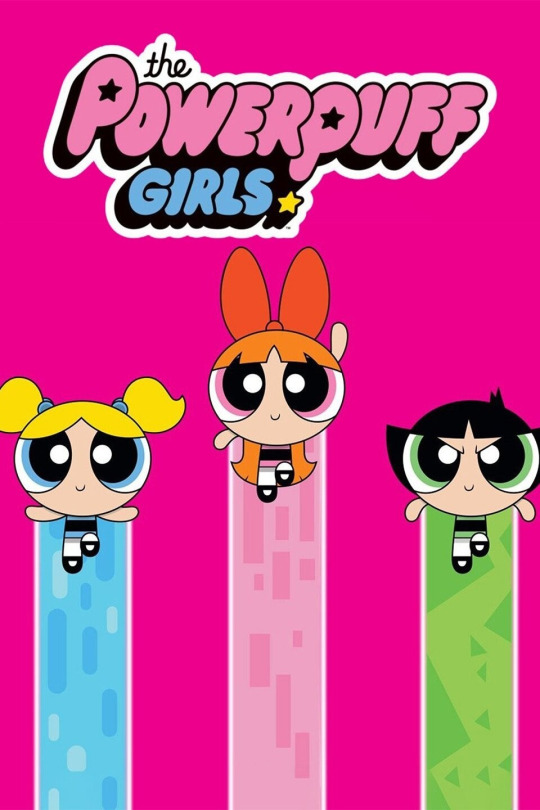
How do structural mythology, cultural studies, and cultural history reflect the series’ world and world-building around superheroes?
The Powerpuff Girls constructs its world through a combination of structural mythology, cultural studies, and cultural history. Structurally, the series adheres to the superhero genre's conventions with the trio of Blossom, Bubbles, and Buttercup representing archetypal hero figures. The cultural studies lens is evident in the show's exploration of diverse characters and themes, challenging traditional gender norms by featuring female protagonists with distinct personalities. Cultural history manifests in the series' context, reflecting the late 1990s and early 2000s ethos, contributing to the development of the Powerpuff Girls' characters, their challenges, and the dynamics within their fictional world.
In what ways are the superheroes and their abilities informed by their racial, gender, sexual, and cultural identities?
The Powerpuff Girls challenges gender norms by portraying the superheroes as three powerful and capable girls, transcending traditional gender roles in the superhero genre. However, the series does not explicitly delve into racial, sexual, or cultural identities. Instead, the characters' abilities and identities are more broadly representative, emphasizing universal themes of empowerment and teamwork, thereby fostering inclusivity. The focus is on their superhero roles rather than specific identity markers, aligning with the series' commitment to a diverse and inclusive narrative.
In what ways do costumes and concealing identities further separate the superheroes from normal society? How necessary is it for the superheroes to hide their true identities to successfully achieve their goals?
Costumes and concealed identities in The Powerpuff Girls serve to separate the superheroes from normal society by creating a distinct superhero persona. Despite their childlike bodies, the girls don't wear masks like the typical superheros, but their costumes signify their superheroic roles. The necessity of hiding their true identities is tied to protecting their personal lives and maintaining a sense of normalcy within the context of their youthful appearances. By concealing their identities, the Powerpuff Girls can navigate both the challenges of superheroism and the mundane aspects of their lives without undue interference or scrutiny. The juxtaposition of their childlike appearance with their superhero responsibilities adds an additional layer of complexity to the need for identity concealment.
How do the economic, political, and social events that occurred during the series’ creation and broadcast cultivate and inform the superheroes’ decisions and actions?
Drawing insights from Kevin D. Williams's article, which explores how superhero narratives reflect societal changes, we can apply this framework to The Powerpuff Girls. The late 1990s and early 2000s, when the series was created and broadcast, were marked by significant cultural shifts. The show aligns with broader societal trends of the time, emphasizing themes of empowerment and diversity, which are likely influenced by the cultural climate of that era. For instance, the late 1990s witnessed a growing awareness of gender equality, and the Powerpuff Girls, as female superheroes, may be seen as a response to or reflection of this cultural shift. The series captures the zeitgeist of the late 20th century and early 21st century, with its characters embodying the values and aspirations of the period.
How do the superheroes question themselves, each other, and their obligations and duties to the people around them?
The series engage in self-reflection and questioning throughout the series. Despite their superpowers, they grapple with typical challenges of growing up, forming their identities, and understanding their roles as superheroes. The dynamics between the sisters involve questioning and occasional conflicts, reflecting the complexities of sibling relationships. The superheroes' obligations and duties to the people around them are generally portrayed positively, with the girls embracing their roles as protectors of their city, but occasional moments of doubt or internal conflict contribute to their character development and the overall narrative.
17 notes
·
View notes
Text
Does the show handle the issues of sexual assault and gender-based discrimination with tact or does it (actively or passively) glorify the perpetrators of the situation?
@theuncannyprofessoro
We Don't Need Another Superhero: The Boys (2018)
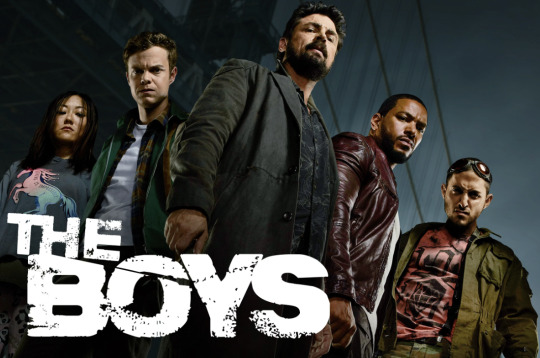
William’s assertion that TV Superheroes symbolize our ever changing “American values” is proven true by The Boys’ (2019) critical reflection of the our 21st century nation’s hierarchical distribution of economic, social, & political power, aggressive foreign policy/patriotism post 9/11, and represents the (much needed) beginnings of progressiveness through its rebellious protagonists. The show surrounds Starlight, the newest member of the Seven (America’s favorite Superheroes/“Supes” managed by Vought, an antagonistic, all-controlling company), who, after being assaulted by her childhood idol on the first night, quickly learns that the group’s heroic image is “written by the marketers.” She teams up with Hugh–our human protagonist whose fiance was murdered by a Supe–and his gang of similarly wronged (and vengeful) misfits to destroy the Seven, and eventually, Vought. The narrative frames Superheroes as the actual villains; Williams states that “with great power comes great responsibility,” but in the Boys’ speculative America, this statement is pretty unfortunate.
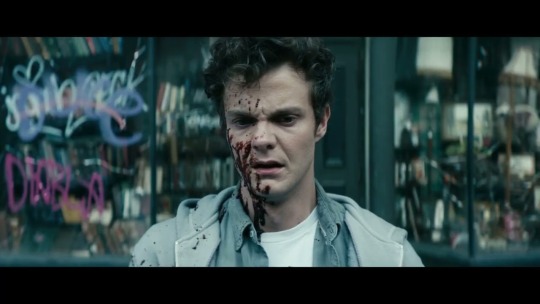
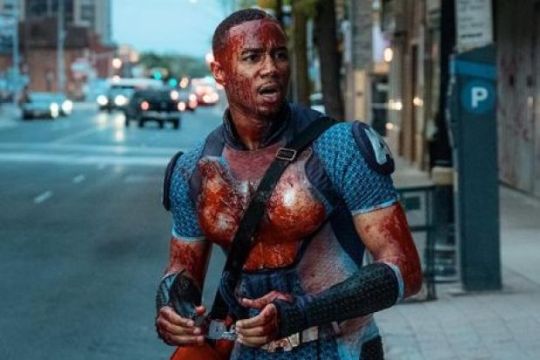
How do structural mythology, cultural studies, and cultural history reflect the series’ world and world-building around superheroes?
The Boys contradicts mythos of the intrinsically good Superhero by exploring the hierarchical, power-based, hegemonic underground world of the Supes, who are closer to flawed–rather than superior–humans. Homelander’s hatred of humans and the Deep’s array of sexual assaults contrasts with their publicly perfect (mythos-based) personas. In terms of cultural studies, the international influence of Vought and its Supes mirrors our unjust attribution of social power. Ezekiel–an antagonist Supe whose homophobic Catholicism contrasts with his secret homosexuality; S1 depicts him angelically floating above crowded young fans while preaching. His sex & drug-filled life is hidden from the naive public, reminding us to question the ideology presented by God-like figures in contemporary society. Superheroes’ mode of “action and conflict” is brutal, gory, in line with 21st century’s chaotic foreign policy. Well described its international standpoint as “America the Violent,” The Boys opens with A-Train literally running through Hugh’s fiance on the street, leaving the bloody protagonist to hold his girlfriend’s (cut-off) hands (the Nation, 2023). If that’s not enough, Homelander kills humans for fun. His destruction mirrors Trump’s reign–“critics say President Trump’s foreign policy has seriously undermined America’s world leadership” (the Hill). Luckily, the fight for progressiveness is represented by both Supes and humans.
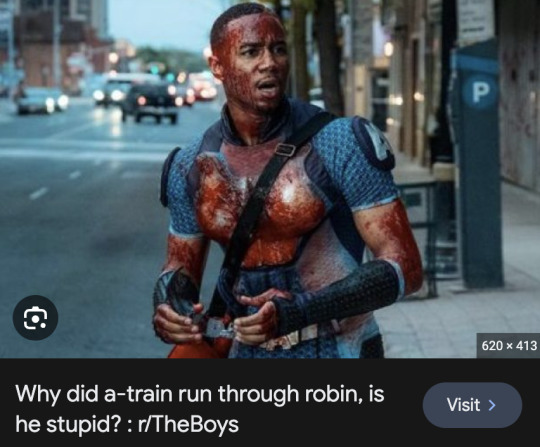
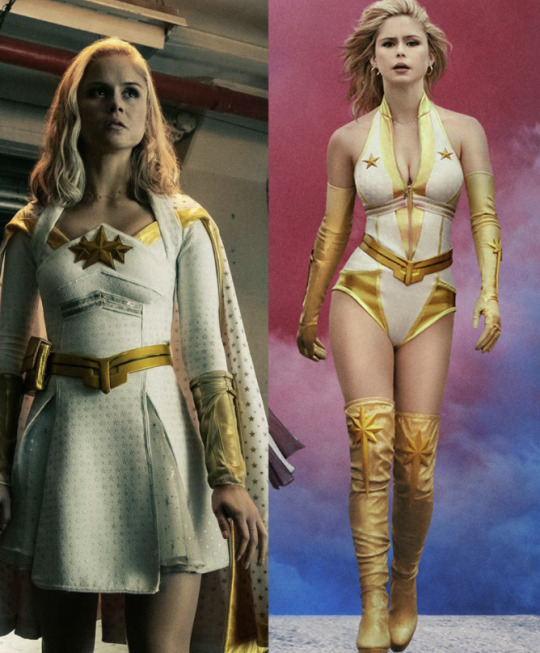
In what ways are the superheroes and their abilities informed by their racial, gender, sexual, and cultural identities?
Despite Vought’s public diversity, their performativity is evident in the structural, identity-related barriers that hinder all members of the Seven (except Homelander, whose straight white identity is, uncoincidentally, the face of America). Homelander’s role in Vought’s decisions (and national power) contrasts with the company’s disregard of A-Train, a Black member of the Seven. His requests��such as an apology from Superhero Blue Hawk (a stereotyping racist who curb-stomped a Black man)--are typically ignored despite his sudden importance for #BLM marketing. Still, A-Train eventually kills Blue Hawk, framing him as stronger than the white, hegemonic structure that attempts to define him. Starlight’s entrance into the celebrity-Superhero world illustrates the struggle of gender; soon after signing her, Vought changes Starlight’s modest costume to a skimpy bikini, threatening to fire her if she doesn’t cooperate. The following scene depicts her in the bikini, men yelling to “show her boobs” in front of her young, innocent fans; gendered sexualization is framed as a barrier, overshadowing her identity as a strong Superhero. Maeve’s bisexuality sheds light on the heteronormativity of the Supe system; after years of hiding her bisexuality, heteronormative Homelander finds out and publicly outs her (in angry jealousy) as a lesbian. Vought’s binary view of sexuality results in their manipulation of this outing as a way to ‘diversify’ and profit–Maeve is marketed as the new face of lesbianism, illustrating her difficulty presenting her true Superhero identity in this binary system. Kimiko–a victim of human trafficking–illustrates intersectionality as female, Japanese, and Super; her cultural difference from the show’s world is evident throughout Season 1, when the boys attempt to ‘figure her out,’ somewhat like an unknown concept. Kimiko’s empowerment in later seasons indicates her contradiction of the hysterical, alien “Female,” and rather frames intersectionality as part of her uniquely heightened strength.
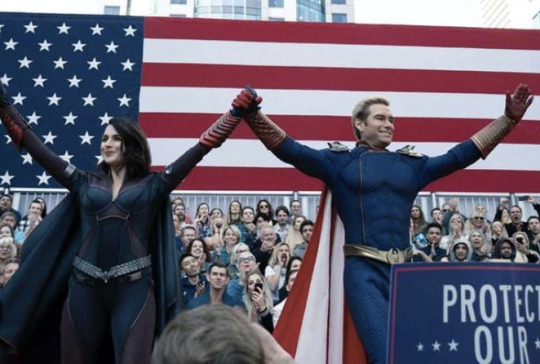
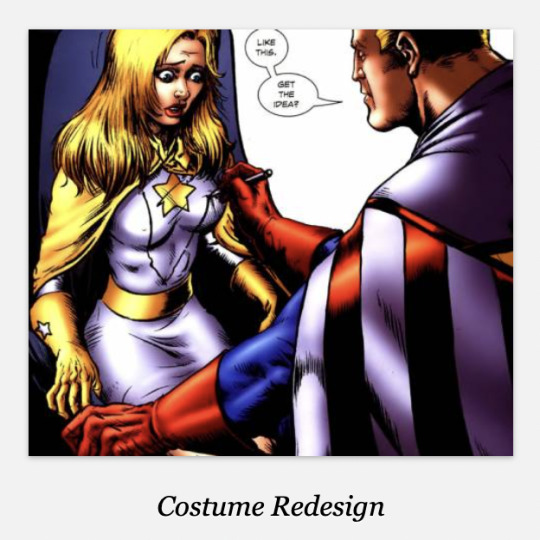
In what ways do costumes and concealing identities further separate the superheroes from normal society? How necessary is it for the superheroes to hide their true identities to successfully achieve their goals?
Costume reflects the humanity (or lack thereof) of Superheroes; Homelander is never shown without his costume on, which alludes to his lack of humanity and hatred of non-Supes. The costume represents his “real” persona while his humanity is “the facade” (1344). His “true,” villainous identity must thus be hidden in order to win the public’s affection and achieve his power-hungry goals. On the other hand, Starlight avoids costume and is framed as the most human Supe. In the first few episodes, we learn about her background through moments with Annie–her real name–while she sits at the bar, bowls, or walks through the park in ‘normal’ clothes. Still, she must hide her true identity to satisfy Vought’s hegemonic idea of success. Kimiko is never seen in costume, and is framed as the sweetest and purest Supe despite her introduction as the most alien. Her lack of interaction with the roles created by Vought (and the costumes that realize them) results in her formation of a singular identity rather than a “super” vs “normal” self like the Seven, and quickly settles into her Superhero strength.
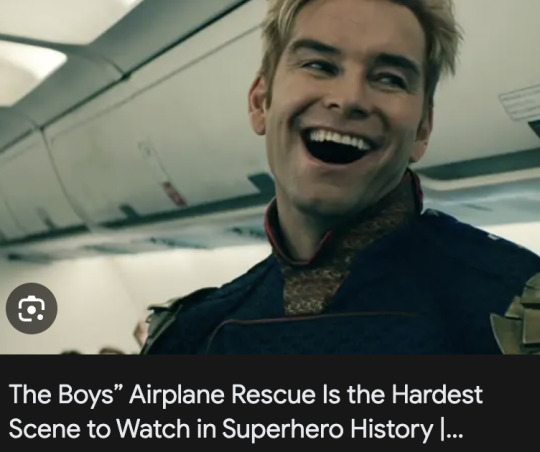
How do the economic, political, and social events that occurred during the series’ creation and broadcast cultivate and inform the superheroes’ decisions and actions?
Superheroes’ paths are informed by economic (human trafficking), social (#MeToo, BLM), and political (terrorism, 9/11) events. Kimiko–a Japanese trafficking victim–fell into a vat of Compound V (Vought’s superhero serum) and gained unusually intense Super-strength. The economic value placed on her extreme strength results in her imprisonment as a lab rat and trafficking into the U.S. Her origin story addresses the nation’s concerning economic flow from human trafficking, pictured in relation to Compound V through Vought’s transnational trade. The #MeToo social movement affects Starlight after her sexual assault in by the Deep, a member of the Seven (E1). While the shows creators considered “behind-the-scenes” revenge narrative, they constructed Starlight’s public revenge with references to #MeToo after the movement’s coincidentally timed real-world emergence; the historical social movement shaped Starlight’s story (the Nation). “Flight 37”--a crashed plane hijacked by terrorists–is likely a political reference to 9/11. When Homelander tries–but fails–to save the plane, he simply leaves everyone to die and pretends he was never there. When the tragedy goes public, he expresses his sorrow through fake tears and a politically oriented speech; he demands the American need for real protection, specifically, Supes in the military. Homelander’s manipulation of a national tragedy to assist his right-wing agenda mirrors 21st century politics under Trump’s guidance.

How do the superheroes question themselves, each other, and their obligations and duties to the people around them?
Stan Edgar (a Vought executive) leads Homelander to question his own capability despite the Supe’s undefeated physical superiority. Edgar’s statement that Homelander is “not a God,” but “simply… bad product” results in Homelander’s atypically poor performance in a fight with Soldier Boy in the following scene (S3, the most important fight of the show). The physical manifestation of Homelander’s insecurity sheds a rare light on his humanity. His creation of an abusive workplace environment means that none of the Supes trust him, especially Maeve, as their past/media-friendly romance gives her more insight than the others. She consistently questions his intentions and thus keeps a poker face, smiling to avoid his (physically threatening) temper; her distrust shows as soon as Homelander leaves and a hidden fear replaces her fake smile. Starlight similarly distrusts and questions her obligation to remain in the Seven, and only stays to please her selfish mother. The eventual discovery that her mother selfishly injected baby Starlight with Compound V dissolves the Supe’s trust of and obligation to her mom; Starlight remains in the Seven, but for moral, personally driven reasons.
@theuncannyprofessoro #oxyspeculativetv
17 notes
·
View notes
Text
Does the mismatched/adoptive status of the family seem to be reminiscent of larger dynamics in the world? I mean, do the siblings seem to represent different kinds of perspectives or ideologies?
@theuncannyprofessoro
The Umbrella Academy- We Don't Need More Superheroes

The Umbrella Academy (2019) is a show that follows a group of adopted siblings, each with their own power, and their journey to solve the mystery of their father’s death and save the world from an impending apocalypse.
How do structural mythology, cultural studies, and cultural history reflect the series’ world and world-building around superheroes?
The Umbrella Academy is set in present day (2019) yet plays around with time and timelines throughout the narrative, as one of the siblings Five has the ability to manipulate time. As for structural mythology, the show is based on the books, yet as a viewer who is unfamiliar with the original content, I would say the show is definitely set up in a mystery, as we are introduced to the siblings in the first episode, yet are constantly in the dark when it comes to the reasoning behind the 43 births and what caused it. Though the narrative setup of the death of guardian/father figure, Dr. Reginald Hargreeves, brings the siblings together to mourn his death, Hargreeves is still shrouded in mystery. What is appealing about Umbrella Academy is the diversity of the siblings themselves, and how they go through their own individual experiences dealing with their powers and how they come together to try and stop the impending apocalypse and save the world. As for cultural history, the show does include many significant moments of history, as many scenes take place in the past due to the constant time warping in the show. For example, the Vietnam War, Civil Rights Movement and even the assassination of JFK are all a part of the show, and each siblings’ experiences in the “past” have a direct impact on their own journeys and also their future.
In what ways are the superheroes and their abilities informed by their racial, gender, sexual, and cultural identities?
To my knowledge there is not necessarily connections between the siblings' abilities and their racial/gender/sexual/cultural identities. But, there are definitely ties between each siblings' emotions and their abilities, especially when it comes to sibling 7 Viktor. At the beginning of the series, Viktor is known as the sibling without any powers, and is ridiculed and ignored by Hargreeves as a result. Viktor sees himself as useless compared to his siblings, but it is later revealed that Hargreeves used pills to suppress Viktor's powers of manipulating sound into physical force because he deemed them to be too dangerous. Viktor unlocks these powers after not taking the pills anymore, and releases his full potential, but struggles to control his powers.
In what ways do costumes and concealing identities further separate the superheroes from normal society? How necessary is it for the superheroes to hide their true identities to successfully achieve their goals?
When the Umbrella Academy is younger and growing up under the tutelage of Hargreeves there is a specific uniform the children wears, which features a school-like red and gray uniform and the iconic and traditional superhero mask. I think most of the difficulties when it comes to the siblings lives is that they each have their own desires aside from their constant missions and family drama. As they encounter different experiences in different timelines, the siblings find love, careers they care about, and other things that are separate from being superheroes.

How do the economic, political, and social events that occurred during the series’ creation and broadcast cultivate and inform the superheroes’ decisions and actions?
In Kevin D. Williams’s “(R)Evolution of the Television Superhero: Comparing Superfriends and Justice League in Terms of Foreign Relations" Williams discusses how many political events and ideologies have a direct impact on the narratives and ideologies of superheroes, specifically with political climate post Cold War and post 9/11. The second season of "The Umbrella Academy" takes place mostly in the 1960s, as at the end of season 1, sibling Five saved all his siblings by taking them to the past, and they are now scattered and each experiencing their individual lives in the 60s. This places all the siblings during Cold War era US, and the narrative specifically forms around JFK's assassination and the Civil Rights Movement, which specifically impacts Allison the most. Allison becomes an active member of the Civil Rights Movement and describes her motivation and empowerment to exist outside her scope of superhero powers, which involve manipulation. I think it is interesting that the show includes the self-doubting aspect of being "super" in some ways because I think it helps make the characters feel more authentic if they're concerned how their powers impact themselves as humans. In season 2, Allison participates in a sit-in at a whites only diner and uses her powers to manipulate a police officer to stop beating her husband Ray. This causes him to run away from her because he is afraid, but the two later reconnect.
How do the superheroes question themselves, each other, and their obligations and duties to the people around them?
Because the main superheroes are siblings, it makes for a really interesting dynamic to watch onscreen. Not only are they a family, but an estranged one that has just been reunited due to the death of their father. Of course they act just like any siblings and question themselves and each other. Because Hargreeves literally numbered them off based on their "usefulness" to him (#1-7) their childhoods were definitely not normal in the sense that he was raising them to serve him. Especially for Viktor, their childhood was extremely traumatizing and his history with certain siblings even causes fights and tension in the present timeline. During one episode, it is revealed Hargreeves instructed Allison to use her powers to manipulate Viktor into forgetting that he had powers. This relevation causes Viktor to lash out at Allison, which speaks to how the siblings' turbulent history still has impacts on their current relationships with each other.
@theuncannyprofessoro
18 notes
·
View notes
Text
When having no quirks is Quirky, does the show comment on uniqueness of individuals? Or are all the non-quirky people the same?
@theuncannyprofessoro
Roundtable Presentation: My Hero Academia

How do structural mythology, cultural studies, and cultural history reflect the series’ world and world-building around superheroes?
My Hero Academia draws heavy influence from Western Superhero comics. The character designs themselves as well as the hero society that is built up reflects a lot of aspects specifically shown in Marvel and DC. My Hero also takes the classic Hero’s Journey mythology concept and portrays this the the main character Izuku Midoriya. He goes from being quirkiness, to inheriting one the most powerful quirks and becoming a hero.
In what ways are the superheroes and their abilities informed by their racial, gender, sexual, and cultural identities?
In My Hero Academia, the characters manifest quirks in a way that is usually completely unique to them. A lot of the times, quirks are influenced by genetic factors with characters usually manifesting a quirk that is similar to a combination of their parents quirk. They are similar to how certain traits are inherited in the real world. A lot of diversity is also shown through the costumes that heroes design for themselves. These designs can incorporate different cultural or personal elements that allow for characters to better express their individuality. for the most part quirks are not determined by racial identity, gender and sexuality.

In what ways do costumes and concealing identities further separate the superheroes from normal society? How necessary is it for the superheroes to hide their true identities to successfully achieve their goals?
In My Hero Academia, there is a whole society of heroes. It takes place in a world where 80% of humans suddenly begin to develop superpowers. Heroes are separated from society in the sense that they are looked up to and depended on by many people with weaker quirks. Being a hero is oftentimes a job that is sought after, with whole schools dedicated to teaching young students to be good heroes. Finding the right costume is important for every heroes journey, usually made to enhance their specific quirk and be recognizable and marketable. It’s not necessary for professional heroes to hide their true identities. Most of the time, being a hero is something to show off especially if you are ranked in the top ten. However, heroes do have a separation when they are on the job vs when they are off. I’ve noticed a trend in the show where older, more established heroes turn on a heroic personality when they are on the job but are completely different in their personal life.
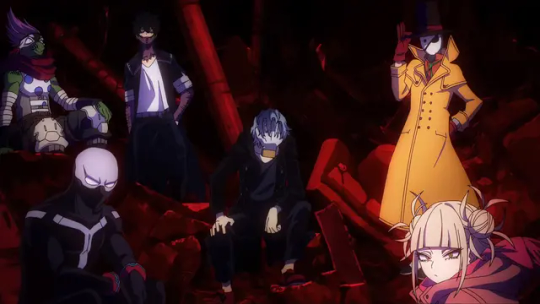
How do the economic, political, and social events that occurred during the series’ creation and broadcast cultivate and inform the superheroes’ decisions and actions?
The emergence of Quirks in the My Hero Academia has social implications especially highlighted in the discrimination and prejudice against those with "villainous" or "unusual" Quirks. This mirrors societal attitudes toward individuals who are perceived as different or other. While the show is not heavily influenced by real life events, a lot of the characters are based on or inspired by classic comic book characters and manga characters.
How do the superheroes question themselves, each other, and their obligations and duties to the people around them?
Many of the older heroes in the show often question themselves and their motives. A few seasons into the show, the viewers start to see that heroes aren’t always good and the hero society is responsible for forcing people into the role as villains. There is also an arc of the show where its’ hard for the characters to trust each other because of double crossing and undercover work. The younger heroes in training seem to have a more optimistic view on being a hero because they are new to the business. Because being a hero isn’t some big secret, those with strong quirks and hero training can jump into action at any point with no worries about being caught.

@theuncannyprofessoro
13 notes
·
View notes
Text
Do you think the show uses worldbuilding in a satisfying way?
@theuncannyprofessoro
WandaVision (We Don't Need Another Superhero Roundtable)
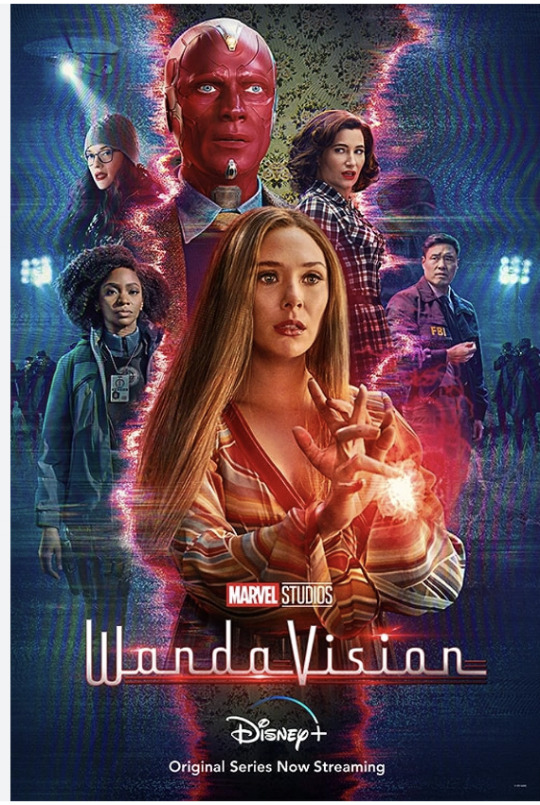
youtube
How do structural mythology, cultural studies, and cultural history reflect the series’ world and world-building around superheroes?
In Avengers: Infinity War, Vision dies twice. In WandaVision it is revealed that in her grief, Wanda created a town and created a new version of Vision that can only exist within the town, even though he had died. The theme of resurrection from the dead is a popular theme in mythology. As one example, the phoenix, according to legend, is a bird with the ability to die and come back to life. It is said that when an old phoenix dies, it bursts into flames and a new phoenix is born from the ashes of the old. There are many different versions of this resurrection myth in Egypt, Europe and Asia.
WandaVision is steeped in cultural studies and cultural history. The world of WandaVision is set as a television show, so it is a television show within a show. Kevin Williams writes, “A cultural history adds the element of time to the study of the narrative’s values, namely how is the change in values over time reflected in the narrative?” WandaVision tackles cultural history by setting each of the episodes in a different time period. The first episode takes place in the 50s. Wanda and Vision are dressed and styled in 50s clothing and their home has the technology associated with the 50s and 50s-style furniture. The episode is shot in black and white like a 50s TV show. Wanda is portrayed as a typical 50s housewife and Vision is a 50s house husband with a job. The first episode they try to blend in with the 50s-style town, including at a dinner with Vision’s boss, even though they don’t have key knowledge. After interrogating Wanda and Vision, Mr. Hart chokes on his food and Vision uses his powers to save him.
In the second episode, WandaVision is transformed to a 60s setting. The show is still in black and white, but some strange items occur in color. At the end, Wanda learns she’s pregnant, she resets their reality and the show turns to color.
The third episode takes place in a 1970s setting and is in color as they prepare for the baby. The show keeps advancing through decades the 80s, 90s, 2000s until the last two episodes of the season when it breaks out of the television show model and focuses on Wanda’s real powers. The entire series is very much steeped in cultural aesthetics of the different decades as their clothing and styling change with each decade. The furniture in their home also changes with each style. Wanda and Vision attempt to blend in to each of the decades since the 50s without attracting attention even though they obviously have great powers that they can’t completely control.
youtube
In what ways are the superheroes and their abilities informed by their racial, gender, sexual, and cultural identities?
Wanda’s gender identity as a woman plays an important role in her story. Ethnically, Wanda comes from Sokovia, a war-torn area that is likely modeled after Eastern Europe, possibly Yugoslavia. Her parents were killed when she was 10 and she was found by the SWORD people.
In episode 1, Wanda and her neighbor Agnes discuss techniques for seducing a man. When Vision’s boss arrives, Wanda makes a very romantic atmosphere and dresses in a fluffy white dress that is meant to seduce Vision. At the end of the episode, Wanda makes wedding rings for her and Vision. In this episode, Wanda’s role as a woman and romantic partner take center stage.
At the beginning of episode 2, after hearing thudding coming from outside, Wanda brings her and Vision’s beds closer together and then turns them into one bed. Vision tells Wanda to turn off the light, again focusing on Wanda as a romantic partner to Vision.
In episode 3, Wanda is pregnant. There seems to be a connection between the baby and her super powers. When Wanda is making the nursery, she feels the baby kicking and then loses control of her powers. Her progress moves up to six months. Vision says at the rate she’s going, they can expect the baby by Friday afternoon. When Wanda feels a tightening sensation, Vision says she’s experiencing Braxton-Hicks contractions. Her powers go haywire and there’s a town-wide blackout. Wanda wonders what will happen when the real contractions start. She wonders if the neighbors know that what’s going on is her fault. She says that people are always on the verge of discovering her secret. When Wanda has a real contraction, it begins to rain in the town. When Geraldine helps Wanda with her birth, electrical appliances turn themselves on, a chandelier crashes, pictures start spinning on the wall, and the fireplace ignites. After she gives birth, everything calms down.The show sets up a possible tension between her motherhood and her super powers, but after giving birth, she retains her powers and ultimately her children have super powers too.
More broadly, Wanda’s desire to live an idyllic life with Vision is the basis for the show. But in her determination to create this life, she is giving new identities to the people of Westview. They become characters on Wanda’s TV show and know no other lives. She in essence keeps the people of the town hostage. This relates to her identity as a woman because she is portrayed as a woman so intent on having a perfect family life with her husband and children that she will destroy the lives of others to achieve it. Wanda’s pursuit of her agenda at the expense of others is consistent with the observation by Kevin D. Williams that “As the questioning of American values and dissension within America concerning the War grew, so did the questioning of the superhero character. No longer was the superhero guaranteed to be an authoritarian do-gooder questioning nothing and blindly carrying out the crusade for American justice” (1336). Indeed, Wanda is a complex character who uses her powers for her own benefit not only to benefit others and even at the expense of others.
youtube
In what ways do costumes and concealing identities further separate the superheroes from normal society? How necessary is it for the superheroes to hide their true identities to successfully achieve their goals?
Wanda and Vision concealing their identities separates them from normal society because they have to go out of their way to make sure their neighbors don’t know what powers they have. WandaVision is consistent with Kevin D. Williams’ article “(R)Evolution of the Television Superhero: Comparing Superfriends and Justice League in Terms of Foreign Relations” when he writes, “Yet, in both series, heroes consciously struggle to maintain these secret identities, and they engage in deceit in order to keep the general public from learning their superhero status.” Wand and Vision don’t have to hide their powers when they’re alone, but in order to conceal the fact that she is a superhero who has taken over the town, without arousing suspicion from the townspeople, it is important for Wanda to conceal her and Visions’ identities.
In episode 1, when he’s at work, Vision’s boss says he’s like a computer and Vision says he’s made of organic matter. His boss then asks if there’s a skeleton in Vision’s closet. Later in the episode, Mrs. Hart almost discovers Wanda’s powers so Vision sings to distract her.
youtube
At a neighborhood watch meeting in episode 2, after being offered a danish, Vision says that he doesn’t eat food, receiving strange looks from the other characters present. To cover up his gaffe, Vision says he doesn’t eat food in between meals but at mealtimes.
In episode 3, Wanda tries to hide her pregnancy from Geraldine who arrives spontaneously. Wanda says it’s not a good time. Geraldine says she needs a bucket because her pipes burst. Wanda says she has a bucket in her kitchen. When Wanda wants to know more about Geraldine’s temp job, Geraldine goes on and on. A stork appears in the background. Wanda tries to make it disappear but her powers aren’t working. When Geraldine comments on the noise that the stork is making, Wanda says it’s her new icemaker.
In episode 5, Agnes shows up at Wanda’s door spontaneously. Vision has to quickly make himself look human because he wasn’t expecting her. Later in the episode, after Wanda tells the twins that taking care of a dog is a huge responsibility, Vision shows up. He looks human. He says he had a hunch someone would pop over. This is when Agnes shows up with a wooden house for the dog, and Vision continues his speech with “with exactly the item we require.” Wanda uses her magic to create a dog collar in front of Agnes. Vision doesn’t understand why. Wanda says that Agnes didn’t notice when the twins aged up from babies to five-year-olds. Vision says it’s not what they agreed upon. He says that Wanda made no effort to conceal her abilities. Wanda says she’s tired of hiding and that Vision doesn’t have to either.
Kevin Williams also writes that Justice League gives an opposing interpretation: the costume is the real character and a secret identity is the false secondary identity. This is true in the case of Wanda, who invented fake personas for her, Vision, and everyone in Westview. She pretends she doesn’t know her true powers, but she actually does, which is seen in episode 3, when she ejects Monica Rambeau out of the town and back into the real world using her powers and then fixes up the damage.
youtube
This quote can also be applied to the character of Agnes, who seems to just be Wanda’s neighbor and oblivious to Wanda’s power, but who later reveals herself to be a witch named Agatha Harkness at the end of episode 7. She was concealing her true identity and was just biding time before she revealed herself.
youtube
How do the economic, political, and social events that occurred during the series’ creation and broadcast cultivate and inform the superheroes’ decisions and actions?
Production of WandaVision began in 2019. During this year, Brexit occurred, President Trump was impeached, evidence for global warming became more clear as the Amazon rainforest burned an area the size of New Jersey, and protestors were in the streets in Hong Kong. Against this backdrop of national and global turmoil, the focus of WandaVision on a seemingly simpler, nostalgic past of sitcoms can be understood as an approach to escape from the threats of reality. During production, a new threat to civilization, the pandemic occurred. Production had to be halted in 2020 for the pandemic. It was completed later that year and WandaVision became one of the few shows that aired in 2021, the height of the pandemic. The longing for escapism through sitcoms and television during the pandemic may well have contributed to the success of the television show. Wanda keeping everyone in a contained bubble could have been an allusion to people having to isolate themselves during the pandemic. Further, the attention paid to TV sitcoms is on the one hand comforting and nostalgic. But the show captures the emotions of the pandemic-stricken world because it upended the calming notion of an unthreatening sitcom and instead turned it slowly but steadily into a scarier and creepier show with each episode nudging in the direction of sitcom turning to horror, similar to life in a pandemic.
How do the superheroes question themselves, each other, and their obligations and duties to the people around them?
In episode 8, Wanda and Agatha question each other. Agatha begs Wanda to reveal how she created the Hex and has Wanda revisit traumatic times from her life. When Wanda reveals how she created the town, Agatha says she knows what Wanda is. Agatha says that Wanda used chaos magic to create the town and that makes her the Scarlet Witch.
youtube
In episode 9, Agatha wants Wanda to surrender her power to her. Agatha says she’ll let Wanda “keep this pathetic little corner of the world all to herself.” Wanda throws her car into Agatha’s house. This is when the new Vision shows up. He lifts Wanda into the air and squeezes her head and says he was told that she was powerful, indicating that he believes that to be false. This is when the real Vision appears and throws the new Vision, which causes an explosion. Wanda says she should’ve told Vision everything the moment she realized what she had done. Vision says he understands why she made the world, but shows concern about it. Wanda says she can fix it. Vision seems doubtful. The new Vision emerges from the flames. Wanda tells Vision that Westview is their home and he says they will fight for it. When Vision and the new Vision fight again, Vision asks why Vision 2 is bent on destroying him. Vision 2 says that Wanda must be neutralized and Vision must be destroyed, and punches Vision in the head. Later, when Wanda is in the street, Agatha sends out a purple blast. She says that Wanda has never been up against another witch before. She says there’s an entire chapter devoted to Wanda in the Darkhold, which is the Book of the Damned. She says that the Scarlet Witch is not born, she is forged. She has no coven and no need for incantation. Wanda says that she’s not a witch, that she doesn’t cast spells, and that no one taught her magic. Agatha says that Wanda’s power exceeds that of the Sorcerer Supreme. She says it’s Wanda’s destiny to destroy the world. Wanda says she’s not what Agatha says she is.
youtube
Soon after this, Agatha cuts off Wanda’s control of the townsfolk. Wanda tells the townsfolk that they’re going to be fine, that she’s kept them safe. The townsfolk say that they feel her pain. Wanda lets out a scream, and accidentally starts choking the townsfolk. After stopping it, Wanda says she’ll let the people go. Agatha asks what’s stopping her. She tells Wanda to let the people go now and that heroes don’t torture people. Wanda sends up a beacon that is changing the town back to the way it was before she changed things. She tells everyone to leave. Vision then falls to the ground and begins to fall apart, as do the twins. Agatha informs Wanda that she tied her family to the twisted world and now one can’t exist without the other. Wanda puts the shield back up and Agatha blasts Wanda and her family. Wanda puts up a protective shield around them.
In the library, Vision says that he does not have one single ounce of original material. He says that Vision 2 has the data but his memories are being kept from him, and he no longer feels like the real Vision after meeting Vision 2. He says that Vision 2’s memory storage is not so easily wiped and unlocks it, causing Vision 2 to say that he is Vision, at which point he blasts through the roof.
Wanda brings Agatha to the past and shows Agatha the destruction she caused. Wanda says the difference between the two of them is that Agatha did it on purpose. Agatha reanimates the dead witches, who chant Wanda’s name. They say that she’s the Scarlet Witch, the Harbinger of Chaos. Agatha says Wanda can’t win, and says that power isn’t the problem. It’s knowledge. Agatha tells Wanda to give her her power and she will correct the flaws in Wanda’s original spell. She says that Wanda and her family and the people of Westview can all live together in peace. No one will have to feel Wanda’s pain again, not even Wanda herself. Wanda tells Agatha to take the power, that she doesn’t want it. Agatha says she wants all the power and Wanda tries to give it to her. Agatha then says that once a spell is cast, it can never be changed. The world Wanda made will always be broken, just like her. Agatha tries to blast Wanda but fails. Wanda reveals the runes she made, which means she’s the only one who can use her powers. She thanks Agatha for the lesson. She says she doesn’t need Agatha to tell her who she is and then transforms into the Scarlet Witch.
youtube
Wanda tells Agatha that she’s going to lock Agatha in Westview in the role she chose; the nosy neighbor. Agatha says Wanda has no idea what she unlocked and that she’s going to need her. Wanda says she knows where to find Agatha and turns Agatha into the nosy neighbor.
10 notes
·
View notes
Text
Do you think that creating its own superhero framework is meant to challenge existing framework or simply present an alternative to the common superhero playbook?
@theuncannyprofessoro
Superheroes Roundtable: Wordgirl

How do structural mythology, cultural studies, and cultural history reflect the series’ world and world-building around superheroes?
Wordgirl (PBS) represents a cultural shift towards the prioritization and valuing of literacy and education for young girls. When the show premiered in 2007, there were not many kids' superhero shows that featured female protagonists. This issue still persists today in both child and adult media. Not only does Wordgirl feature a young female protagonist, but her superpowers subvert traditional expectations of violence and fighting. To platform spelling and literacy as “powers” is to highlight the value of these abilities in our society.
In what ways are the superheroes and their abilities informed by their racial, gender, sexual, and cultural identities?
It is interesting to consider this question in relation to Wordgirl’s character because while her gender is platformed and even included in the name of the series, her racial identity is purposefully abstracted and blurred. While Wordgirl is technically from the planet Lexicon, and thus is not affiliated with any known race or ethnicity, she has light brown skin and thus could arguably resemble/represent multiple different races. As a young woman of color, usually facing off against male-presenting adversaries, her identity never hinders her ability to defeat her enemies with her impressive vocabulary.
In what ways do costumes and concealing identities further separate the superheroes from normal society? How necessary is it for the superheroes to hide their true identities to successfully achieve their goals?
While I think in traditional superhero narratives, concealing identity is very necessary in ensuring the safety of the character in their day to day lives, I would argue that Wordgirl plays off of this trope and even satirizes it. Her disguise is a cape and a mask that covers just her eyes, and most of her enemies interact with her regularly when she is not in her superhero costume. It is very clear who her real identity is, however the show has her wear the cape and mask to call attention to these tropes and solidify its place as a less serious yet no less important superhero text.
How do the economic, political, and social events that occurred during the series’ creation and broadcast cultivate and inform the superheroes’ decisions and actions?
Besides the political relevancy discussed in question #1, individual epsidoes of the show sometimes mirror socio-political events. For example, an episode aired in 2009 in which one of Wordgirl’s recurring enemies, Toby, runs for president. Given that the episode aired the year following the 2008 presidential election, it is clear that the showmakers sometimes wanted to feature topics that were especially culturally and politically relevant.
How do the superheroes question themselves, each other, and their obligations and duties to the people around them?
The show picks up after Wordgirl has already decided that she wants to use her powers to save people and catch criminals. Because she is self assured and confident in her role and the way to harness her powers for good, an internal struggle surrounding her obligations does not have a place in the show. She fights crime and teaches villains how to spell not out of obligation but out of a desire to do so, which I think is a valuable type of empowerment to show in a series for kids.
@theuncannyprofessoro
17 notes
·
View notes
Text
The Venture Bros.
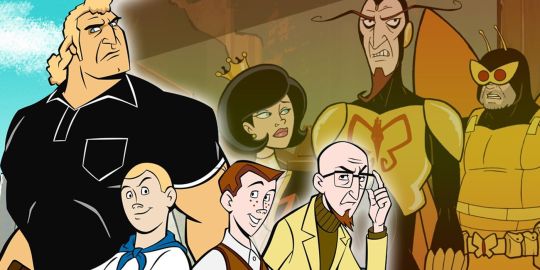
The Venture Bros. comments on many assumptions from the Golden and Silver Age of comics. It parodies certain elements of comic book history, including ‘the boy adventurer’ (Jonny Quest) trope and space-age fiction themes and aesthetics. The series follows Dr. Thaddeus “Rusty” Venture, a sad failure of a Super Scientist living in the shadow of his late larger-than-life father, Dr. Jonas Venture. Rusty is a superhero in title but not in practice, yet he still has a rotating cast of villains and sidekicks around him. His arch nemesis is a villain called The Monarch, who I focus on for this piece. I think Rusty represents the more cynical, morally ambiguous Silver age of comics while his father represents the authoritarian Golden age, to put it into Williams’ framework from “(R)Evolution of the Television Superhero”. The Venture Bros contributes to a misanthropic view of superhero narratives. All of the characters have major flaws directly connected to their association with Super Heroism and its flipside, Super Villainy. Changes in values over time are shown in the narrative through flashbacks and convoluted storylines involving many characters over several seasons. Overall, though, the series pokes fun and levies criticism against prevalent superhero notions.
The Monarch, Dr. Venture’s Arch Nemesis, is a scrawny, goateed, middle-aged white male who has made a career out of being evil. In some ways, he is very successful, with an awesome spaceship headquarters, a team of devoted henchmen, and a sexy villainess girlfriend. However, the Monarch is shown to oscillate between overconfident and insecure, as seeking validation, and as unable to thwart his self-proclaimed nemesis, no matter how many opportunities he gets.

The Monarch represents an attitude of dissatisfaction among men who actually have quite a bit going for them. I feel like this reflects a culture of misplaced victimhood held by some men as the liberation of women and other oppressed groups makes them feel like they are losing some kind of power or status.
The Venture Bros. is all about funny costumes and character design. The Monarch has leaned all the way into his butterfly-and-insect-themed villainy. His costume is an integral part of his character, and he is rarely seen without it.
His voice and mannerisms are enough to make the Monarch recognizable even when he is not in costume, but he derives much of his power from his outfit, the consistent theme of his evil operation, and his flashy technology. The Monarch has a hard time performing villainy when not in costume. In this universe, Villany is a career, and the job requires a uniform.
The show is definitely influenced by 9/11 and the entrance of Gen Xers into the media scene. The show debuted in 2003, when the Cold War Kids (not the band) were finally entering the workforce and the public eye and expressing their feelings and attitudes about social and political realities of the time. The Monarch is an expression of social, economic and political disillusionment that can go in divergent directions and lead to extremism. Venture represents apathy and adherence to established systems, despite their idiocy.
In Season 1 Episode 11, the viewer gets a glimpse into the normal and domestic side of super people when they meet members of The Guild of Calamitous Intent when Venture hosts a yard sale at his compound. He invites all the Villains he works against and among, with the understanding that no harm can come to him because it is not guild-approved and therefore the villains have no legs to stand on in terms of evil.
Even so, the Monarch, Dr. Venture’s sworn enemy, wreaks non-approved havok at the yard sale, causing a brawl in search of a suitable bathroom. Monarch and Dr. Girlfriend sneak into the compound and see the sad emptiness of Dr. Venture’s life. For a moment it seems the Monarch has a realization about his Villainy and almost gives up “Arching” Dr. Venture, but when the security team gives him a fright, the Monarch vows to destroy Dr. Venture and reconstitutes the Nemesis status.
I think this faltering of ideology that the Monarch experiences shows how perceived obligations are subject to change situationally. This applies to foreign relations because attitudes about domestic policy, domestic views on other countries, and also relationships between nations and states are products of history but also are fluid.
@theuncannyprofessoro
21 notes
·
View notes
Text
Three Body Response

In the first episode of Three Body, there is a scene about 23 minutes in where Detective Shi, the general, and Wang Miao are all speaking in a room with couches and chairs about Frontiers of Science. The general is trying to convince Wang Miao to join Frontiers of Science to provide information, though it seems like a very dangerous task.
In this scene they utilize wide shots which show Wang Miao and the general in relation to one another. In these wide shots, the general sits so that his face is in shadow, but the details of his uniform are visible. This visual choice connects to Dyson’s assertion that “created worlds of science fiction are read as representations of political life, revealing cultural assumptions about international conflict” (461). I believe the choice to obscure the general’s face makes a point about the apparent non-humanity of the government and how ironic it is given that the state is supposedly run by people. The general is asking Wang Miao to risk his life for a matter of national security. I think that this reveals both a mistrust and certain admiration of military society and the power it has over the populace. The man does not have power–his uniform does.
@theuncannyprofessoro
1 note
·
View note
Text
I found this to connect to a thing in the pilot episode where the scientist being interviewed on TV likened the explosive development of technology to the spread of cancer in the body. By making technology a sickness, the show also suggests humanity as a kind of sickness, because any technology we create is an extension of ourselves and our nature.
@theuncannyprofessoro
Three-Body Problem

Stephen Benedict Dyson's article titled “Images of International Politics in Chinese Science Fiction: Liu Cixin’s Three-Body Problem,” compares the Three-body series with Kenneth N. Walts Three Images of international relations offering different interpretations of the dynamics of conflict. It is mentioned that both of the writhed view human nature as being malevolent and place the most emphasis on the idea of survival that is perpetuated by an international and interstellar system. Walts developes a framework “1) to enable one to “see” that which cannot be directly perceived; 2) to bound the realm of activity one wants to explain; 3) to filter out those aspects of thought and action not essential to the coherent understanding of international events.”(465) You can see the malevolence of human nature that is portrayed in the series through the first episode during one of the flashbacks. Ye Wenjie responded to a signal at Radar Peak. At first she was hesitant but ended up responding and inviting her respondents to take earth. She felt like the population on earth had become selfish and unable to solve all of the problems that they were the ones to create. It took aliens coming to earth to try and rectify all the problems that humans inherently cause.
1 note
·
View note
Text
Very interesting point about the disjointed nature of the opening sequence. This whole episode was very challenging to follow, exemplifying the intention of the creators to dispel any notions that this universe is one that is familiar to us. The disorientation happens early as a way of preparing us for what's to come, perhaps?
@theuncannyprofessoro
Response 12
Stephen Benedict Dyson's article, "Images of International Politics in Chinese Science Fiction,” explores the ways in which the genre of science fiction opens up possibilities to deconstruct the frameworks and systems we use to organize and make sense of reality. From the beginning of episode 1 of “Three Body” (2003), the showmakers already direct our attention to a series of disorienting images and events that—without the full context—we can’t quite configure into orderly, sequential, and logical information. We first see a graphic of tiny microscopic shapes and figures continuously zooming further and further out to make new patterns and textures in a larger configuration. We then see a woman sending a message off to space as the camera focus on the clock in an implied countdown. Because of the way our brains process media, it is instinctual to want to contextualize the images we are shown in the opener, despite the show not allowing us to do so. This aligns with Dyson’s claim that the goal and main triumph of science fiction narratives and the images used to communicate them is that they detach viewers from socially constructed reality. After the opening scene, the central plot of the show begins, when we discover a group of scientists have committed suicide and that the most recent case shows the writing “Physics doesn't exist.” This statement, which ends up taking a significant role in the plot, also nods to the idea that systems like math and science are socio-societal constructions.

@theuncannyprofessoro
10 notes
·
View notes
Text
Does the show seem to support the "bad seed" idea where Hitler is evil in all scenarios or are there any scenarios the show explores where he turns out to be normal and his evil never materialized?
@theuncannyprofessoro
Love Death + Robots: Alternate Histories

This 8-minute episode of Love Death + Robots, Alternate Histories”, explores the fictional concept of an Alternative History Research App, Multiversary. The app allows users to “modify any historical fact” in order to simulate what major events that occurred after would change and what possible new events could be presented. One of the most popular requests of the research app that we see from the episode is the death of Hitler, and what would happen if he died at a different point in his life in different ways.
youtube
What is the koinos kosmos (common world) and mutually assumed knowledge the series shares with viewers?
The series is episodic, however, in this particular episode, the mutually assumed knowledge shared with its viewers is Hitler’s lifespan leading up to his death in 1945, his interest in art and writing in earlier years of his life as the episode depicts this in every new alternate timeline that is simulated. Additionally, common events appear in every timeline such as the space race or the world wars, however, the episode delves into alternative depictions of these events, for example having different countries or even identities land on the moon first, or presenting different ‘victors’ and allyships during both world wars if they even occur in these new timelines. The current age of technology is another piece of mutually assumed knowledge the series shares with viewers, as technological advancement is explored in numerous ways, for example, the shift from horse-drawn carriages to automobiles and the implication of that if it happened at an earlier time in Germany.
How does the series depict cultural hybridity through the alerted history’s role in reflecting and reshaping cultural assumptions?
Even with certain technological advancements and events being depicted as inevitable in every alternate timeline, the episode highlights the obsession with the exploration of space and how it was (and still is) fueled by the competitive nature of nationalistic identity under the guise of advancement for all of humanity. Regardless of who manages to land on the moon first, the series plays on how this event, coined as “a giant leap for all mankind” is riddled with all sorts of American culture, technology, and imagery e.g. the American flag that is placed on the moon as an indicator of “humanity’s presence.” We see different countries place their own flags and use their own technology to reach the moon.
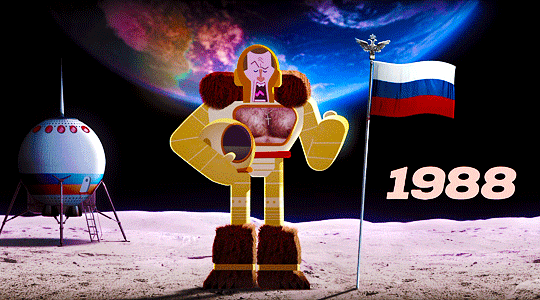
How does the series depict the power of understanding world creation?
The episode places a large importance on Hitler's impact on the events of the current world, or the “future” if we’re viewing 1908 as the “present” in the episode. Whether an earlier death can create those particular timelines or not, the episode has an emphasis on chain reactions and how individuals can be incredibly large catalysts in how the world is created.
In what ways do formulations of the past, present, and future engage with prospective realities of what might have been and what might be in the series’ alerted history?
The episode revels in formulating absurd and bizarre futures such as a rat society that is built upon an earth completely destroyed by nuclear war alongside its more digestible formulations of alternate pasts of known events such as the different victors of the Great War, but the series does a great job of engaging both through quick and concise descriptions of how this sort of timeline can emerge all from Hitler’s death. The animation style definitely makes it much simple to tie it all together, especially with the graphical elements utilized.
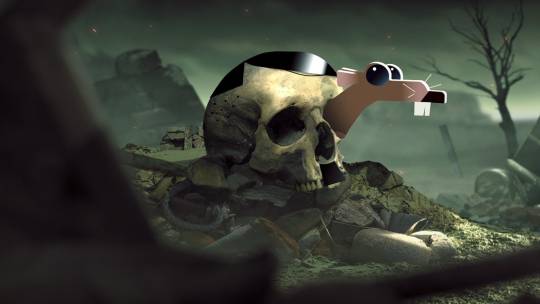
How do multiple realities or contemplations of multiple realities merge with questions of authenticity?
The questions of authenticity aren’t explored too much, since what comes before the events of the episode start are more or less considered historical fact, at least from the perspective of American Research, however, from the initial dialogue about the capability of what the Multiversary app can do (modify any historical fact) does merge these questions of authenticity, as we can then question what exactly is authentic about the common world and what isn’t about these alternate timelines. Who is to say some of the events simulated in the alternate timelines haven’t or can’t occur, and are the historical facts that align with the history that is documented and researched by a single nation’s perspective truly authentic?
@theuncannyprofessoro
26 notes
·
View notes
Text
Does Koala Man lead you to believe there is some inferiority complex currently among Australians? Or is it just a funny joke?
@theuncannyprofessoro
History Redesigned: Koala Man (2023-)

Koala Man takes place in Australia. However, in this universe, the Titanic never sank, leading to the destruction of America and a superiority complex among Australians. In episode 3, an Ameircan named Chad Wagon begins to plot to make Australia the next America 2.0.
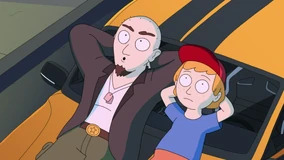
What is the koinos kosmos (common world) and mutually assumed knowledge the series shares with viewers?
It’s common knowledge that nationalism in America is unlike anywhere else, to the point where some Americans genuinely believe that all global politics revolve around them. Koala Man makes fun of America’s extreme patriotism through uses of satire and farce. Chad Wagon is the stereotypical American, wreckless, and constantly thinking about hot dogs, hamburgers, and ketchup.
How does the series depict cultural hybridity through the alerted history’s role in reflecting and reshaping cultural assumptions?
In episode 3, Nicole Kidman is revealed to be Australia’s queen, a figure both Australian and American viewers know well. By placing an American-Australian icon at the head of the table, Koala Man pokes fun at the fact that America has trouble accepting anyone with any ties to another country as a true American.
How does the series depict the power of understanding world-creation?
The series uses the character Maxwell to provide understanding to the historical changes the series makes. At the beginning of episode 3, an old and tired Maxwell is placed at a bar, reflecting on how he changed the world. In the Koala Man universe, different time zones actually adhere to the numerical time a moment happens, so Australia being 19 hours ahead of America, actually knows what happens in America 19 hours before America does. Thus, when Maxwell was young, having learned of the Titanic sinking, breaks what’s known as The Red Hot Rule, and sends a telegram to warn the Titanic captain of what's to come. Maxwell’s plan works, and he is able to prevent the sinking of the Titanic, but this singular event launches into another, leading to the election of a Mummy President and the self-destruction of America. Maxwell’s narration and telling of The Red Hot Rule provides the context for the world that Koala Man is set in.

In what ways do formulations of the past, present, and future engage with prospective realities of what might have been and what might be in the series’ alerted history?
With Koala Man being set during a time where all of America is set in flames (except for Hollywood which broke itself off and is now a floating island), Koala Man allows for a universe where Australia is a major power free of American influence. Furthermore, the concept of The Red Hot Rule leaves characters grappling with the choice to alter other major disasters.
How do multiple realities or contemplations of multiple realities merge with questions of authenticity?
The concept of multiple realities and timelines that go along with Koala Man’s interpretation of time zones leaves audiences wondering whether major historical events, such as the sinking of the Titanic, were authentic or were they set in motion by fate. Koala Man episode 3 tells us that the sinking of the Titanic needed to happen, and if that’s the case, do we really have control of our future?

@theuncannyprofessoro
21 notes
·
View notes
Text
Do you think the show would still be good if it made huge, world-shattering changes to history? Or is that above its paygrade?
@theuncannyprofessoro
Roundtable Presentation: History Redesigned
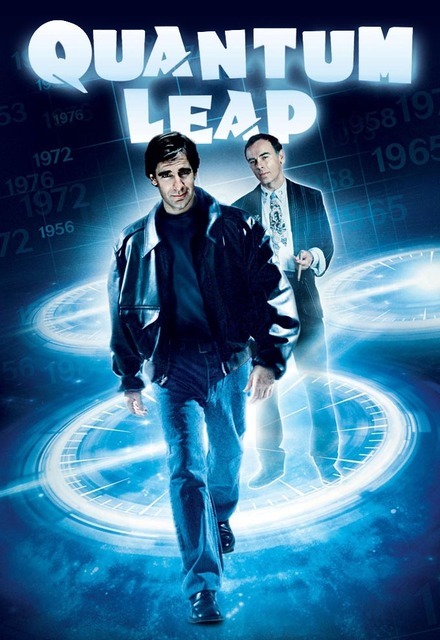
What is the koinos kosmos (common world) and mutually assumed knowledge the series shares with viewers?
Quantum Leap is a show where a scientist named Sam Beckett is a time traveler stuck in the past who leaps into different people's bodies in order to change something in history for the better. This background is also provided in the show’s intro to keep this context in the viewer’s mind as a shared understanding. The two episodes I focused on were Season 5 Episodes 1 and 2 which follow Sam as he leaps into Lee Harvey Oswald, the assassinator of John F. Kennedy. These episodes start with a disclaimer that states “The following story is based upon the known evidence and established facts collected in the three decades since the JFK assassination.” These episodes then shift into a collage of historic photos of JFK during his lifetime. While it is not expected that the viewer is a complete expert as more context is provided throughout this two-part storyline, Quantum Leap assumes that the viewer has surface-level knowledge of who John F. Kennedy is and his assassination.
youtube
(Stop at 1:00) - Introduction
How does the series depict cultural hybridity through the alerted history’s role in reflecting and reshaping cultural assumptions?
Typically in time travel media, the time traveler travels as themselves throughout time. Quantum Leap, however, takes a different approach where it incorporates body switching into the time travel arena. This new incorporation blurs the lines between two individuals as they become one. In these two episodes in particular, Sam struggles with maintaining himself and his own morals while in the body of Oswald. Throughout the two episodes Sam struggles to not lose himself claiming he cannot control Oswald as he is taking over his mind. There was a part of Oswald that merged into Sam when he leapt making him more aggressive. He continually had to fight and snap out of this connection. This mergence questions the balance between varying personalities and views. It also reflects upon ones mental strength to not lose oneself in the presence of immense influence as well as reshapes the audience’s understanding of self.

Additionally, during the majority of the two episodes it is assumed that Sam leapt back in time for the purpose of saving John F. Kennedy, but in reality this is not what ends up happening, which shifts the viewers' consideration of what really is “for the better.” They have to shift their mindset of what the situation needed because saving JFK might have led to a series of unforeseen cause-effect events. Due to this both Sam and the viewers had to readjust to realize that it was unrealistic to save JFK, but the real goal was to save Jackie, John F. Kennedy’s wife. When reflecting upon JFK’s assassination it is a common assumption that if he wasn’t killed, the United States would be in a better spot, but this change in viewpoint questions whether or not changing this huge event would actually have had an overall positive influence. This challenges both Sam and viewers to question their initial assumptions of a situation, suggesting that these interpretations might not always be as straightforward, or even complex, as they first seemed.
youtube
How does the series depict the power of understanding world-creation?
Quantum Leap assumes that world creation is constant, interconnected, and ever changing with many aspects influencing and building upon themselves. The show also assumes that time is not set as there could be multiple outcomes through time travel changes, however, in all instances the shaped creation story remains the same. The timelines that Sam jumps into are slightly alien, but his skills and knowledge transfer and function in these varying realities because they all still share a common backbone. Furthermore, the series attempts to answer the question of who we are and what is one’s individual purpose. Everytime Sam leaps he does so with the goal of figuring out what is there for him to fix in hopes of leaping home. This constant striving for improvement shows Sam’s path towards discovering why he is there.
In what ways do formulations of the past, present, and future engage with prospective realities of what might have been and what might be in the series’ alerted history?
This ties back to the whole premise of the show. In Quantum Leap, Sam has to figure out who he is, why he is there, and what he has to fix so that history can move forward on the path it is meant to take. Sam leaps back and forth throughout time to change reality so that it is on its best path, suggesting that what was going to happen, or what might have been, is not what should be. This alteration of reality and perspective is prominent in the Lee Harvey Oswald episodes because originally he assumed that the reason he leaped into Oswald was to save John F. Kennedy from being assassinated or to figure out the truth behind the conspiracies revolving around JFK’s assassination. However, Sam later discovers that what he thought he was there for might not actually be why he is meant to be there. In particular, in these episodes he jumps around in multiple time periods all in Oswald’s body which further complicates things. Thus, his understanding of the situation and the differentiation between the past, the present, and the future become interconnected. Once the task is completed, reality changes making everything even more intermixed and blurring the lines between history and reality.
How do multiple realities or contemplations of multiple realities merge with questions of authenticity?
Given how in Quantum Leap Sam goes back in time and alters history as different individuals, it forces audiences to question what is real, what was meant to be, and what is original. The changes of history made in the show, however, have to be plausible enough that it is believable that it could happen. Since the changes that take place are influential, but not overly dramatic or impractical, it is easy for viewers to buy into this interpretation of the altered reality. While the changes do have an impact on reality, they are changes audience members can still wrap their head around because they are not so overly unfamiliar that viewers can still see it as an authentic option for reality.
@theuncannyprofessoro
20 notes
·
View notes